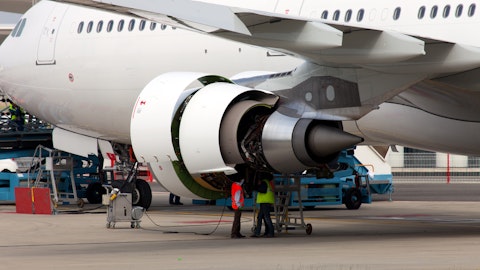Gavin Parsons: Can you just talk a little bit about how you position the China truck business to reduce margin volatility if demand does fall off?
Chip Blankenship: Well, there’s really no way to position it to reduce volatility if demand falls off. We are just trying to say that when demand is strong, it’s a profitable, good business. And when demand is not strong, we fall below a certain level. It’s a bit of a drag on the overall Industrial segment. And so, we are trying to have enough levers in our planning process that we are able to deal with that as it comes through. And that’s how we planned 2024 is delivering at that peak volume type of level in the first quarter. The other quarters we planned and are ready to deliver on all of our other product lines into all of our other end markets and make that plan.
Gavin Parsons: Got it. Great. And then maybe just in terms of your price strategy, you’ve talked about kind of value pricing. Where are we today in terms of getting price just as inflation pass-through versus implementing your value pricing strategy?
Chip Blankenship: We are pretty early in the days in terms of value pricing strategy. I think that really comes into play on new product introductions where we are able to provide a component or a system to a customer that provides more value than the last system does. And so that’s where that muscle comes into play and confidence comes into play. As far as our current portfolio, we have opportunity in the aftermarket in some product lines to price for value there, where our products are highly differentiated, to have plenty of IP in them to deliver value compared to more standard parts that are more of a commodity. We don’t — aren’t able to command that type of value pricing in the aftermarket. So that’s how I think about it right now. But as far as really developing that capability, it’s going to be applied mostly to the new products.
Gavin Parsons: Okay. Thank you.
Operator: Your next question comes from the line of Gautam Khanna from TD Cowen. Please state your question.
Gautam Khanna: Yes. Hi. Thanks. I was wondering at the Investor Day, what might be different in your presentation this year than in prior years? Like what — can you just give us a sneak preview into what you guys anticipate discussing?
Chip Blankenship: A sneak preview. Gautam, I love your questions. You’ve always got something for us. I guess the sneak preview is that you’re going to see more players on the stage. And folks are going to talk about their businesses. Experts are going to talk a little bit about their products and what value they provide to customers. And I truly believe we’ll tell a compelling story, just like we did last time about the exciting content that we have on, for example, narrow body aircraft that is going to pay dividends long into the future and that our Industrial alternate fuel solutions are going to be highly valuable no matter which way our customers and energy sources go in the future.
Gautam Khanna: Thanks. And I was wondering if you could talk about visibility in the industrial market outside of CNG, where you’ve guided — obviously, Q2, a lot lower [indiscernible] that business. How do you feel about the other major product categories and end markets to reciprocating engines and what have you.
Chip Blankenship: It still feels relatively strong, Gautam. It feels like from the demand for standby power remains strong. The equipment businesses in mining and agriculture remains strong. Marine remains mostly strong, per my earlier comments. We haven’t received any market softening signals from our customers. We’ve received some signals to reduce or push out orders in marine. But we feel like that signal was largely due to some over ordering. Now with relatively better confidence in the supply chain, it’s normalizing as well as, we think, end of the calendar year inventory management. So we feel like every signal that we test in the marine, oil and gas and power generation markets still feed back to us that they want us to deliver at the rates we are projecting. And we still have past due that we are trying vigorously to burn down.
Gautam Khanna: Thank you.
Chip Blankenship: Yes.
Operator: Your next question comes from the line of Louis Raffetto from Wolfe Research. Please state your question.
Louis Raffetto: Hey, good evening, guys. How are you?
Chip Blankenship: [Indiscernible]
Louis Raffetto: Good. I apologize, I may have missed some of these, but did you tell us what the full pricing was? I know you had upped it from 5% to 7%. Did you actually say what it end up being for the year?
Dan Provaznik: No. No, we did not, Louis, did not give that update.
Louis Raffetto: Can you give it? Or we have to wait for the — okay.
Bill Lacey: We’ll say we met what we discussed and exceeded it.
Louis Raffetto: Okay. And then I guess just for you, Bill, the tax step up, what’s driving that step-up in ’24?
Bill Lacey: Yes. As we see our earnings increase, Louis, we are — our tax rate increases along with that. And so that’s really the key driver there is the increased earnings.
Louis Raffetto: All right. And then one more, just I may missed it, the step up in CapEx.
Bill Lacey: Yes. Yes. On the CapEx piece here, we continue, again, as we talk about our capital allocation and where we can get returns, we see that in an area where we have automation opportunities, we want to continue to invest in our — in the maintenance of our machines to continue to drive productivity as well as safety. So that’s really what — where we are looking at investing in our CapEx increase.



